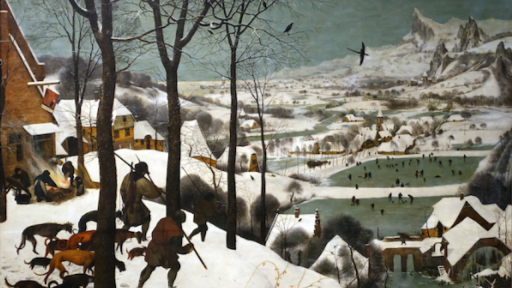Verily the Boyes Who Art Moste Goode
Medieval and renaissance art was often pedagogical in purpose, meaning that it implicitly taught a lesson to the audience. Dogs were part of these moralizing messages. However, their meaning varied greatly depending on context. They could be loyal, noble companions or greedy, lascivious beasts. So, for this blog post, I found some canine art from Google Arts and Culture, which I will use to answer that most pressing of questions: Who's a good boy?!
Hunters in the Snow
Official Verdict: Good boys!
This 16th century oil painting is one of the most famous of the Northern Renaissance. It is part of a series on the seasons of the year; this one obviously represents winter. In it, two hunters look out over a snowy landscape, where human houses are engulfed by white fields, dead trees, and looming mountains. This painting conveys a feeling of human insignificance. But all hope is not lost! Accompanying the hunters is a pack of faithful dogs, who trudge through the snow with the same weariness. Even on the coldest days of the year, these dogs will come to the aid of their human companions.
Beware of Luxury
Official Verdict: Not a good boy.
In this rather busy Dutch artwork, it may take a second to find the little dog eating a meat pie right off the table (far left, about halfway up). Also interesting to note is the pig in the bottom right corner.
This is another one of those moralizing Protestant artworks from the late 17th century (so maybe a little late for Medieval and Renaissance, but it's so fun that I wanted to include it.) In it, the lady of the house has fallen asleep at the table and all hell has since broken loose.
Take note of:
-The child smoking a pipe
-The Quaker (and pet duck) absorbed in the Bible
-The barrel of beer spilling freely on the floor
-The violinist, who we can only assume was the Soundcloud rapper of the 17th century
-The child in the foreground who is literally casting pearls before swine
At the center of the painting is a prostitute looking right at the viewer and holding the husband's... wineglass. Not a good look.
So, this little dog is here to contribute to the chaos of the scene. He symbolizes greed and even lust, teaching the audience what not to do.
Lastly... I promised medieval art, so here is a super fun page from a 13th century French manuscript:
Official Verdict: Don't let the mitre fool you... he's a sneaky boy.
Okay, so Reynard the fox isn't technically a dog. But the concept is the same. Reynard was an anthropomorphic fox character of medieval fables in France, the Netherlands, Germany, and England. These apparently hilarious adventures pit Reynard against his scheming wolf uncle Isengrim, while secretly satirizing the church and the king. While he may look like a pious preacher with a crook and mitre, he is leading these birds astray to eat them. However, he's really the one we're all rooting for, so maybe he isn't so bad after all.

I laughed out loud at "soundcloud rapper of the 17th century," also way to flex on us all with your art history knowledge! Fantastic post
ReplyDelete